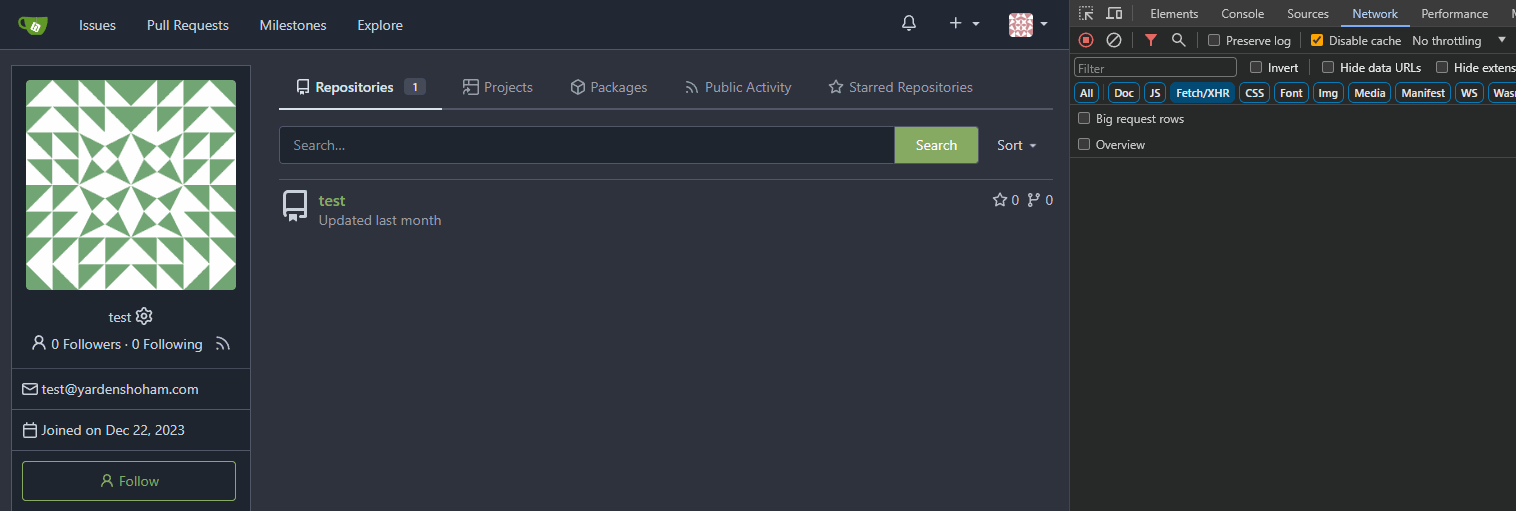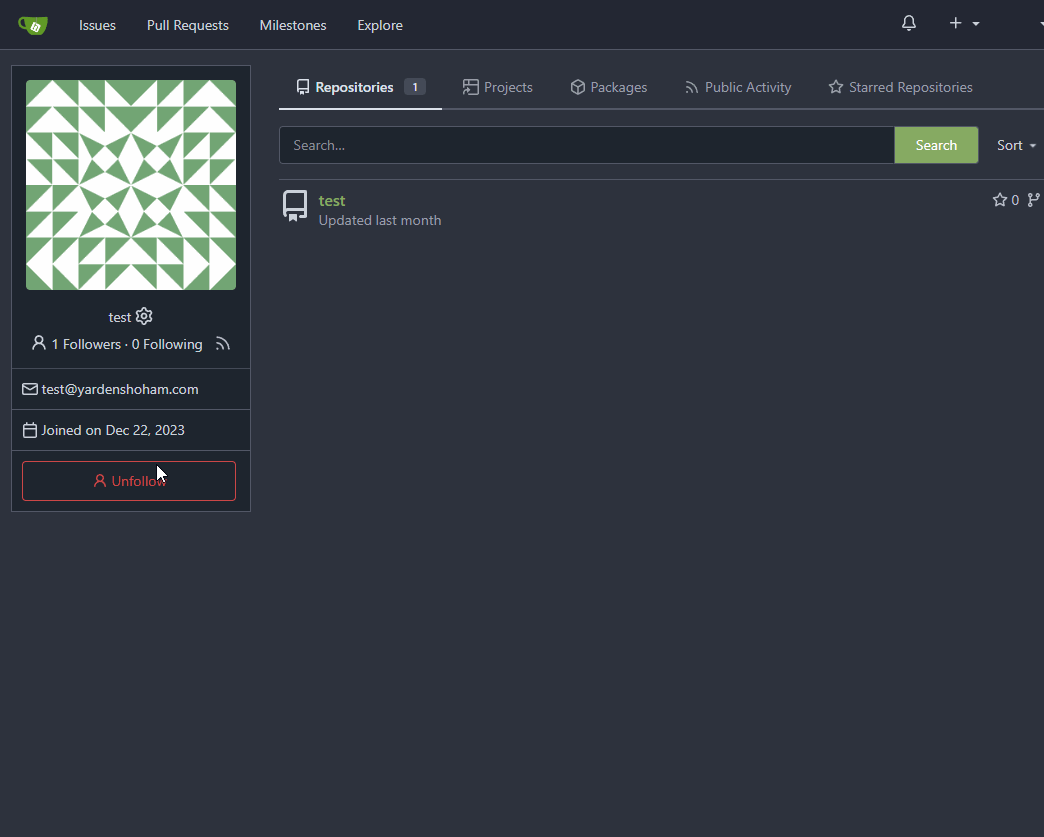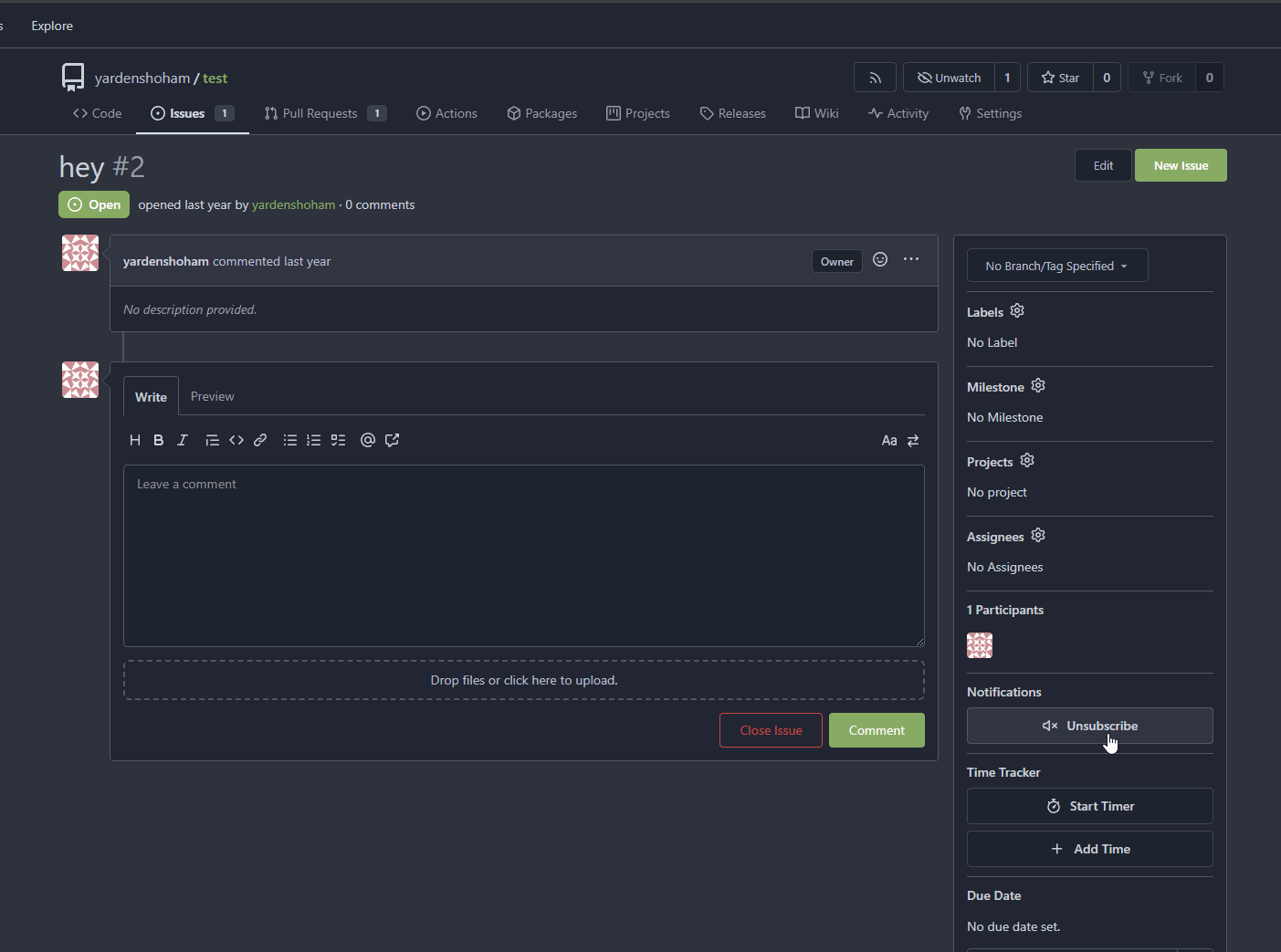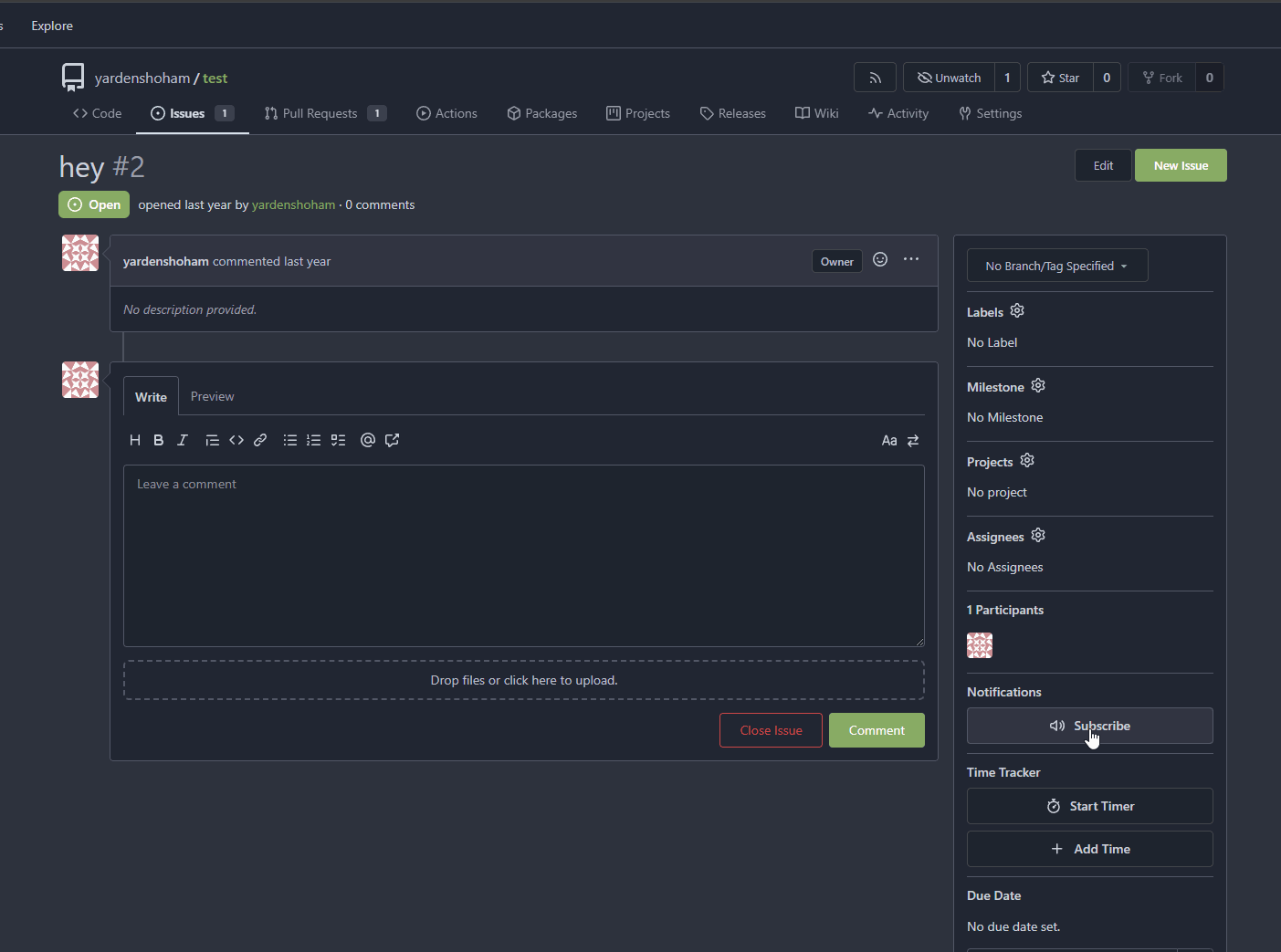- Closes https://github.com/go-gitea/gitea/issues/28880
This change introduces htmx with the hope we could use it to make Gitea
more reactive while keeping our "HTML rendered on the server" approach.
- Add `htmx.js` that imports `htmx.org` and initializes error toasts
- Place `hx-headers='{"x-csrf-token": "{{.CsrfToken}}"}'` on the
`<body>` tag so every request that htmx sends is authenticated
- Place `hx-swap="outerHTML"` on the `<body>` tag so the response of
each htmx request replaces the tag it targets (as opposed to its inner
content)
- Place `hx-push-url="false"` on the `<body>` tag so no changes to the
URL happen in `<form>` tags
- Add the `is-loading` class during request
### Error toasts in action

## Don't do a full page load when clicking the subscribe button
- Refactor the form around the subscribe button into its own template
- Use htmx to perform the form submission
- `hx-boost="true"` to prevent the default form submission behavior of a
full page load
- `hx-sync="this:replace"` to replace the current request (in case the
button is clicked again before the response is returned)
- `hx-target="this"` to replace the form tag with the new form tag
- Change the backend response to return a `<form>` tag instead of a
redirect to the issue page
### Before

### After

## Don't do a full page load when clicking the follow button
- Use htmx to perform the button request
- `hx-post="{{.ContextUser.HomeLink}}?action=follow"` to send a POST
request to follow the user
- `hx-target="#profile-avatar-card"` to target the card div for
replacement
- `hx-indicator="#profile-avatar-card"` to place the loading indicator
on the card
- Change the backend response to return a `<div>` tag (the card) instead
of a redirect to the user page
### Before

### After

---------
Signed-off-by: Yarden Shoham <git@yardenshoham.com>
Co-authored-by: 6543 <m.huber@kithara.com>
Co-authored-by: Giteabot <teabot@gitea.io>
Renames it to `ENABLED` to be consistent with other settings and
deprecates it.
I believe this change is necessary because other setting groups such as
`attachment`, `cors`, `mailer`, etc. have an `ENABLED` setting, but
`oauth2` is the only one with an `ENABLE` setting, which could cause
confusion for users.
This is no longer a breaking change because `ENABLE` has been set as
deprecated and as an alias to `ENABLED`.
## Purpose
This is a refactor toward building an abstraction over managing git
repositories.
Afterwards, it does not matter anymore if they are stored on the local
disk or somewhere remote.
## What this PR changes
We used `git.OpenRepository` everywhere previously.
Now, we should split them into two distinct functions:
Firstly, there are temporary repositories which do not change:
```go
git.OpenRepository(ctx, diskPath)
```
Gitea managed repositories having a record in the database in the
`repository` table are moved into the new package `gitrepo`:
```go
gitrepo.OpenRepository(ctx, repo_model.Repo)
```
Why is `repo_model.Repository` the second parameter instead of file
path?
Because then we can easily adapt our repository storage strategy.
The repositories can be stored locally, however, they could just as well
be stored on a remote server.
## Further changes in other PRs
- A Git Command wrapper on package `gitrepo` could be created. i.e.
`NewCommand(ctx, repo_model.Repository, commands...)`. `git.RunOpts{Dir:
repo.RepoPath()}`, the directory should be empty before invoking this
method and it can be filled in the function only. #28940
- Remove the `RepoPath()`/`WikiPath()` functions to reduce the
possibility of mistakes.
---------
Co-authored-by: delvh <dev.lh@web.de>
The `ToUTF8*` functions were stripping BOM, while BOM is actually valid
in UTF8, so the stripping must be optional depending on use case. This
does:
- Add a options struct to all `ToUTF8*` functions, that by default will
strip BOM to preserve existing behaviour
- Remove `ToUTF8` function, it was dead code
- Rename `ToUTF8WithErr` to `ToUTF8`
- Preserve BOM in Monaco Editor
- Remove a unnecessary newline in the textarea value. Browsers did
ignore it, it seems but it's better not to rely on this behaviour.
Fixes: https://github.com/go-gitea/gitea/issues/28743
Related: https://github.com/go-gitea/gitea/issues/6716 which seems to
have once introduced a mechanism that strips and re-adds the BOM, but
from what I can tell, this mechanism was removed at some point after
that PR.
- Use htmx to perform the button request
- `hx-headers='{"x-csrf-token": "{{.CsrfToken}}"}'` to authenticate (we
should probably learn to reuse this)
- `hx-post="{{.ContextUser.HomeLink}}?action=follow"` to send a POST
request to follow the user
- `hx-target="#profile-avatar-card"` to target the card div for
replacement
- `hx-swap="outerHTML"` to replace the card (as opposed to its inner
content) with the new card that shows the new follower count and button
color
- Change the backend response to return a `<div>` tag (the card) instead
of a redirect to the user page
# Before

# After

Signed-off-by: Yarden Shoham <git@yardenshoham.com>
- Refactor the form around the subscribe button into its own template
- Use htmx to perform the form submission
- `hx-boost="true"` to prevent the default form submission behavior of a
full page load
- `hx-sync="this:replace"` to replace the current request (in case the
button is clicked again before the response is returned)
- `hx-target="this"` to replace the form tag with the new form tag
- `hx-push-url="false"` to disable a change to the URL
- `hx-swap="show:no-scroll"` to preserve the scroll position
- Change the backend response to return a `<form>` tag instead of a
redirect to the issue page
- Include `htmx.org` in javascript imports
This change introduces htmx with the hope we could use it to make Gitea
more reactive while keeping our "HTML rendered on the server" approach.
# Before

# After

---------
Signed-off-by: Yarden Shoham <git@yardenshoham.com>
Sometimes you need to work on a feature which depends on another (unmerged) feature.
In this case, you may create a PR based on that feature instead of the main branch.
Currently, such PRs will be closed without the possibility to reopen in case the parent feature is merged and its branch is deleted.
Automatic target branch change make life a lot easier in such cases.
Github and Bitbucket behave in such way.
Example:
$PR_1$: main <- feature1
$PR_2$: feature1 <- feature2
Currently, merging $PR_1$ and deleting its branch leads to $PR_2$ being closed without the possibility to reopen.
This is both annoying and loses the review history when you open a new PR.
With this change, $PR_2$ will change its target branch to main ($PR_2$: main <- feature2) after $PR_1$ has been merged and its branch has been deleted.
This behavior is enabled by default but can be disabled.
For security reasons, this target branch change will not be executed when merging PRs targeting another repo.
Fixes #27062
Fixes #18408
---------
Co-authored-by: Denys Konovalov <kontakt@denyskon.de>
Co-authored-by: delvh <dev.lh@web.de>
As more and more options can be set for creating the repository, I don't
think we should put all of them into the creation web page which will
make things look complicated and confusing.
And I think we need some rules about how to decide which should/should
not be put in creating a repository page. One rule I can imagine is if
this option can be changed later and it's not a MUST on the creation,
then it can be removed on the page. So I found trust model is the first
one.
This PR removed the trust model selections on creating a repository web
page and kept others as before.
This is also a preparation for #23894 which will add a choice about SHA1
or SHA256 that cannot be changed once the repository created.
By clicking the currently active "Open" or "Closed" filter button in the
issue list, the user can toggle that filter off in order to see all
issues regardless of state. The URL "state" parameter will be set to
"all" and the "Open"/"Closed" button will not show as active.
Fixes #26548
This PR refactors the rendering of markup links. The old code uses
`strings.Replace` to change some urls while the new code uses more
context to decide which link should be generated.
The added tests should ensure the same output for the old and new
behaviour (besides the bug).
We may need to refactor the rendering a bit more to make it clear how
the different helper methods render the input string. There are lots of
options (resolve links / images / mentions / git hashes / emojis / ...)
but you don't really know what helper uses which options. For example,
we currently support images in the user description which should not be
allowed I think:
<details>
<summary>Profile</summary>
https://try.gitea.io/KN4CK3R

</details>
---------
Co-authored-by: wxiaoguang <wxiaoguang@gmail.com>
Fixes #27114.
* In Gitea 1.12 (#9532), a "dismiss stale approvals" branch protection
setting was introduced, for ignoring stale reviews when verifying the
approval count of a pull request.
* In Gitea 1.14 (#12674), the "dismiss review" feature was added.
* This caused confusion with users (#25858), as "dismiss" now means 2
different things.
* In Gitea 1.20 (#25882), the behavior of the "dismiss stale approvals"
branch protection was modified to actually dismiss the stale review.
For some users this new behavior of dismissing the stale reviews is not
desirable.
So this PR reintroduces the old behavior as a new "ignore stale
approvals" branch protection setting.
---------
Co-authored-by: delvh <dev.lh@web.de>
- Make use of the `form-fetch-action` for the merge button, which will
automatically prevent the action from happening multiple times and show
a nice loading indicator as user feedback while the merge request is
being processed by the server.
- Adjust the merge PR code to JSON response as this is required for the
`form-fetch-action` functionality.
- Resolves https://codeberg.org/forgejo/forgejo/issues/774
- Likely resolves the cause of
https://codeberg.org/forgejo/forgejo/issues/1688#issuecomment-1313044
(cherry picked from commit 4ec64c19507caefff7ddaad722b1b5792b97cc5a)
Co-authored-by: Gusted <postmaster@gusted.xyz>
Fix #28157
This PR fix the possible bugs about actions schedule.
## The Changes
- Move `UpdateRepositoryUnit` and `SetRepoDefaultBranch` from models to
service layer
- Remove schedules plan from database and cancel waiting & running
schedules tasks in this repository when actions unit has been disabled
or global disabled.
- Remove schedules plan from database and cancel waiting & running
schedules tasks in this repository when default branch changed.
Fix #27722
Fix #27357
Fix #25837
1. Fix the typo `BlockingByDependenciesNotPermitted`, which causes the
`not permitted message` not to show. The correct one is `Blocking` or
`BlockedBy`
2. Rewrite the perm check. The perm check uses a very tricky way to
avoid duplicate checks for a slice of issues, which is confusing. In
fact, it's also the reason causing the bug. It uses `lastRepoID` and
`lastPerm` to avoid duplicate checks, but forgets to assign the
`lastPerm` at the end of the code block. So I rewrote this to avoid this
trick.

3. It also reuses the `blocks` slice, which is even more confusing. So I
rewrote this too.

Mainly for MySQL/MSSQL.
It is important for Gitea to use case-sensitive database charset
collation. If the database is using a case-insensitive collation, Gitea
will show startup error/warning messages, and show the errors/warnings
on the admin panel's Self-Check page.
Make `gitea doctor convert` work for MySQL to convert the collations of
database & tables & columns.
* Fix #28131
## ⚠️ BREAKING ⚠️
It is not quite breaking, but it's highly recommended to convert the
database&table&column to a consistent and case-sensitive collation.
fix #28436.
the doc https://docs.gitea.com/usage/profile-readme maybe also need to
be updated to tell that
the main branch is necessary,which means the following three conditions
should be satisfied:
- repo: **.profile**
- branch: **[default branch]**
- markdown: **README.md**
Introduce the new generic deletion methods
- `func DeleteByID[T any](ctx context.Context, id int64) (int64, error)`
- `func DeleteByIDs[T any](ctx context.Context, ids ...int64) error`
- `func Delete[T any](ctx context.Context, opts FindOptions) (int64,
error)`
So, we no longer need any specific deletion method and can just use
the generic ones instead.
Replacement of #28450
Closes #28450
---------
Co-authored-by: Lunny Xiao <xiaolunwen@gmail.com>
The CORS code has been unmaintained for long time, and the behavior is
not correct.
This PR tries to improve it. The key point is written as comment in
code. And add more tests.
Fix #28515
Fix #27642
Fix #17098
Nowadays, cache will be used on almost everywhere of Gitea and it cannot
be disabled, otherwise some features will become unaviable.
Then I think we can just remove the option for cache enable. That means
cache cannot be disabled.
But of course, we can still use cache configuration to set how should
Gitea use the cache.
The 4 functions are duplicated, especially as interface methods. I think
we just need to keep `MustID` the only one and remove other 3.
```
MustID(b []byte) ObjectID
MustIDFromString(s string) ObjectID
NewID(b []byte) (ObjectID, error)
NewIDFromString(s string) (ObjectID, error)
```
Introduced the new interfrace method `ComputeHash` which will replace
the interface `HasherInterface`. Now we don't need to keep two
interfaces.
Reintroduced `git.NewIDFromString` and `git.MustIDFromString`. The new
function will detect the hash length to decide which objectformat of it.
If it's 40, then it's SHA1. If it's 64, then it's SHA256. This will be
right if the commitID is a full one. So the parameter should be always a
full commit id.
@AdamMajer Please review.
- Remove `ObjectFormatID`
- Remove function `ObjectFormatFromID`.
- Use `Sha1ObjectFormat` directly but not a pointer because it's an
empty struct.
- Store `ObjectFormatName` in `repository` struct
Refactor Hash interfaces and centralize hash function. This will allow
easier introduction of different hash function later on.
This forms the "no-op" part of the SHA256 enablement patch.
Fix #28056
This PR will check whether the repo has zero branch when pushing a
branch. If that, it means this repository hasn't been synced.
The reason caused that is after user upgrade from v1.20 -> v1.21, he
just push branches without visit the repository user interface. Because
all repositories routers will check whether a branches sync is necessary
but push has not such check.
For every repository, it has two states, synced or not synced. If there
is zero branch for a repository, then it will be assumed as non-sync
state. Otherwise, it's synced state. So if we think it's synced, we just
need to update branch/insert new branch. Otherwise do a full sync. So
that, for every push, there will be almost no extra load added. It's
high performance than yours.
For the implementation, we in fact will try to update the branch first,
if updated success with affect records > 0, then all are done. Because
that means the branch has been in the database. If no record is
affected, that means the branch does not exist in database. So there are
two possibilities. One is this is a new branch, then we just need to
insert the record. Another is the branches haven't been synced, then we
need to sync all the branches into database.